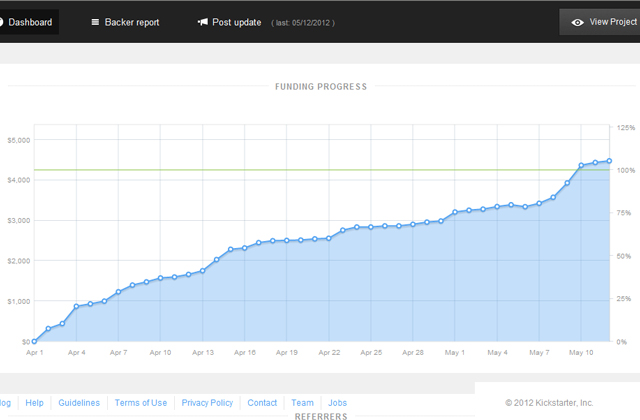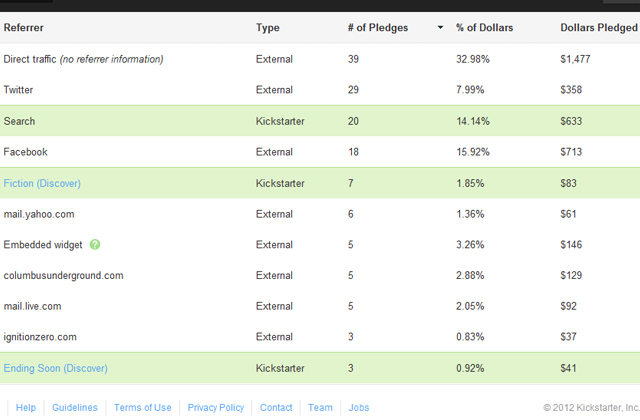Build a Successful Kickstarter
So your product is ready, and now all you need are the funds to bring it to the market. Except you don’t have the funds available so you turn to Kickstarter to raise the money.
 It seems simple—you fill in the summary, offer some rewards, then wait for the money to roll in. And I imagine if you already have a following of people, it might be that easy. But most of us are starting from scratch with poor families, so we have to rely on whatever skills we can scrounge up to pull it off.
It seems simple—you fill in the summary, offer some rewards, then wait for the money to roll in. And I imagine if you already have a following of people, it might be that easy. But most of us are starting from scratch with poor families, so we have to rely on whatever skills we can scrounge up to pull it off.
We can. You can.
Obviously there are countless ways to go about this and hit whatever goals are set, but for the sake of experience, these tips are going to follow the model I used to make my Kickstarter campaign successful.
Study Other Successful Projects
The first thing I did was read. I clicked on current projects in my field of publishing which had already surpassed their goals and studied their pages. How were they getting 200%, 300%, even 1,000% funded?
This research helped me figure out different ways to raise more funds without spending money I didn’t have. Like personalized messages for higher rewards and uniquely written flash fiction stories.
 By looking at other similar projects, I was able to create a list of questions customers would ultimately want answered. And then this list eventually turned into my entire Kickstarter page, because that’s essentially what every Kickstarter is—an information dump. But by looking at other Kickstarters, I was able to research answers for questions I would have never thought of. Sometimes those questions bring up things you might not have factored into the campaign, and when you’re asking for a specific amount of money, you need to be very precise so you can follow through with what you promise.
By looking at other similar projects, I was able to create a list of questions customers would ultimately want answered. And then this list eventually turned into my entire Kickstarter page, because that’s essentially what every Kickstarter is—an information dump. But by looking at other Kickstarters, I was able to research answers for questions I would have never thought of. Sometimes those questions bring up things you might not have factored into the campaign, and when you’re asking for a specific amount of money, you need to be very precise so you can follow through with what you promise.
And if you come across other successful campaigns, and you’re curious about something, go ahead and message the project manager and ask them your questions. Kickstarter is meant for the community to lean on each other in order to bring new projects into the world. Advice is free. So what’s it hurt to ask? I asked several project managers about the specifics of their success, and I’ve returned the favor by answering everyone who’s asked me for advice.
Rewards/Summary—Less Really is More
Now you’re faced with the dreaded blank space of your Kickstarter’s main page. What to fill it in with? Well, hopefully you’ve done the research to answer the important questions.
For me, I thought of my page as a query letter. Here’s my opening sentence:
The Memory Eater anthology has been compiled, edited, illustrated and is waiting patiently for its release. That’s where you come in!
Right off the bat I say where I’m at in the process and that I need help to get any further. I follow that up by going into what my product is. Then I give some background on how I got to this point. Then how I’m going to use the funds. Then the rewards. Contributors.
Pictures were important so people could visualize the rewards. The best way to get these pictures is by getting proofs before the campaign. A local press gave me the proof I used with The Memory Eater logo on a gray t-shirt. For my bookmark, I did that myself in Photoshop.
I suggest having one fun/weird/eye-catching reward. Mine was renaming the main character in my story after whoever bought the reward. I also threw in a personalized line of dialogue I’d have the character say, and it would appear in bolded text. That $300 reward was gobbled up within the first few days. Backers love unique rewards, but remember, they’re only unique in small quantities. Once you start adding more, you begin diluting the quality.
One important thing you’ll want to keep in mind during the creation stage is that less is more.
I recently watched a special on the success of Costco, and how they only offer 4,000 items compared to 40,000 items the average supermarket carries. Walmart stocks 100,000 items. Yet Costco is the most successful warehouse store, holding 50% of the market share. Their advice? Less is more. They basically do the picking ahead of time for the customers. They don’t offer 30 different kinds of mustard—instead they might offer two.
It’s called sensation overload, and it’s when a customer is so confused by all of the choices presented to them that they just give up and walk away.
So when you chose your rewards, don’t overdo it. Don’t try and get too fancy. My advice is to set up a tier system. At the top, you have your main product. For me, it was The Memory Eater paperback and ebook. Below that, you set up your promotional items, like t-shirts, bookmarks, signed copies, art. I wouldn’t go over a handful. And then on the bottom, you simply bundle the above products together and offer them at discounted prices. In the end, you may have a lot of rewards, but you’re not introducing a new item each time.
The last thing I want to touch on is offering samples. I put together a sampler with four stories and uploaded it to Dropbox so people could download and view it on any device they wanted. I think it’s important to give people a taste of what you’re offering. If your project is in a different medium, show pictures. Be as detailed as possible, but be sure not to give too much away.
The Video Presentation
Kickstarter highly suggests you should do one, and so do I, but if you can’t produce a quality video with audio that doesn’t shred ears and dialogue that doesn’t make people gag, then simply skip it. Don’t risk bringing down the value of your project with a poor video.
Pre-launch Checklist
I just launched, now back me!
Hold on there, Dude. Did you remember your pre-launch checklist?
Uh…what?
Your pre-launch checklist should consist of the places you intend to advertise your project.
Now you don’t have to be a social media expert to spread the word about your project. You do, however, have to put in a lot of work. Don’t make the mistake of thinking that you can simply spam your Facebook friends three times daily, begging them, eventually demanding them, to give you money.
First off, you’ll need to use more than Facebook. The internet is vast, and even though you think at the close of each day that you’ve completed it, you haven’t. There are millions of places you haven’t been, and it’s your job to find the places you need to go.
Look for forums and message boards. They’re free, and most of them will allow an advertisement here and there. For my project, I scoured the internet for writing sites with forums or message boards. Here’s a picture of the craziness!
I kept an Excel file and added places to advertise as I found them. To make things easier, I added the specific link directing me exactly where to post when my project went live. The important thing here is that you have to read. You can’t just go post an advertisement on the mingling forum. You have to read the different forum descriptions and find the exact area where you can set up shop. If you don’t, you’re just wasting time, because your posts will be deleted, and you’ll most likely get banned.
So come up with a list of places to advertise. Include Facebook groups. Again, look for places seeking your content. For me, I searched for reading and writing groups.
It’s all about finding your market.
Also on the pre-launch checklist, locate every local media outlet you can. Newspapers. Magazines. Stores. The radio/TV. Contact these places, let them know that you’re local and what your project is and what you’re trying to do. Local places love locals who go for it. Taking a crack at success. Add these places to your lists. Contact them to gauge interest, and then to find out what they’ll need from you. They’ll most likely want some sort of press release, which brings me into the next step of the pre-launch…
Write everything ahead of time. Write your formal pitch that you’ll be posting on the message boards and forums. For me, this was a condensed, 3-5 paragraph version of my Kickstarter summary. It stated what the project was and how people who were interested could help. Sandwiched in there, I included what Kickstarter is and how it works.
For the media, you’ll want to write a press release. This is just a longer version of your formal pitch, and it’s written entirely in facts. No opinions. The only difference is it starts out with an introduction to you instead of the project. And sprinkled throughout the pitch are more details linking you to the area in question.
Facebook is easier. All you’ll need to do is write up a paragraph summary of your project and how you’re trying to fund it through Kickstarter. Then when your project is launched, you first copy and paste the link into your new message, making your project appear below, then you paste your paragraph summary, asking people to visit the page.
It’s important to never beg or tell people what to do. If they like what you’ve pitched, and they want more, they’ll go willingly to visit your page. And if they like what they see there, they’ll most likely back your project.
Begging and telling only turns people off, and once you lose their interest, chances are, you won’t be getting it back anytime soon.
Adapting During Your Campaign
I have my pre-launch checklist, and now I’m live, so back me?
Let me tell you this right now—your campaign is going to be filled with highs and lows, most likely more lows than highs. So it’s a long, long war. You can win a battle one day and lose all of the following for the next week. But you’re never dead unless you give up. Even when it looks bleak, you have to keep fighting. For example, Steampunk Holmes had $9,000 raised with 4 days to go, but it needed $29,000 to be successful. The project ended up raising $43,000. So that’s $34,000 raised in under 4 days!
What I’m saying is that you can’t just post on the forums and message boards, Facebook, Twitter, Google+ and expect fresh faces to constantly read over and back your work. It helps, yes, but as the war progresses, you need to adapt.
One way I adapted when things looked bleak was to turn to Twitter. It’s the platform that helped me get 230 submissions for my anthology, so I figured I’d give a new approach a shot.
I made the cover of my book, the bird eating the human’s brain, my Twitter profile picture, pitched my project in the summary and linked the Kickstarter page below that.
Then I started following all of the people my target audience. People I thought would enjoy the book. Once I followed them, I figured they’d see my profile picture, be intrigued enough to read my summary, then be intrigued enough to follow the link and read over my project. I simply presented myself in a way that wasn’t pushy and let the product speak for itself and the customer decide on their own.
I picked up dozens of backers this way. Sure, it was a lot of work for a few hundred dollars, but every little bit helps when you really believe in your project and you want nothing more than to hit the goal.
 Another way to adapt is to listen to feedback. During my campaign, I had several backers send me questions and suggestions. The suggestions were about bundling several objects that previously weren’t. I also came up with a few more rewards and implemented them into the tier system. One was selling a bundle of 10 books for $120 instead of $150, saving the buyer $30. The reward earned a backer, giving my project a huge boost.
Another way to adapt is to listen to feedback. During my campaign, I had several backers send me questions and suggestions. The suggestions were about bundling several objects that previously weren’t. I also came up with a few more rewards and implemented them into the tier system. One was selling a bundle of 10 books for $120 instead of $150, saving the buyer $30. The reward earned a backer, giving my project a huge boost.
When I had questions to answer, I got back to the people right away. Always be kind and courteous, and if you can, go beyond the customer’s expectations. I worked as a waiter for many years, and nothing was better than satisfying a customer so much that they came back and asked for me personally. Plus, if you make your customers happy, show them that you’re willing to listen to their advice, address their concerns, there’s a good chance they could spread the word about your campaign.
Word of mouth is always a huge boost.
Keep Everyone in the Loop
Post updates on your Kickstarter page. Every time you do so, everyone who backed your project receives the update as an email. And every time you do so, the public can check out what’s going on.
Nothing’s better than being honest about where you’re at and what you’re doing behind the scenes. People want to know that you’re working hard. Since you’re most likely a stranger to them, it shows that you’re willing to deliver. That you’re going to work even when the campaign is over. That you’ll be able to follow through with your promises.
Remember, Not Everyone Knows What Kickstarter is
I’ve pitched my project to countless people in person, and many of them were more than happy to give me their support, only when I directed them to Kickstarter and they learned they had to use their credit cards, a lot of people said never mind.
The truth is, Kickstarter is new even though it launched in 2008. I only first heard of it several months ago when a contributor mentioned giving it a shot. The game Wasteland 2, which raised $2,933,252, and now Pebble, which raised $10,266,845, have done wonders in propelling Kickstarter into the limelight, but people are still wrapping their brains around it.
So it’s your job to make sure that people know it’s safe and secure. Here’s how I pitched Kickstarter to people:
Kickstarter is a unique Internet funding platform for creative projects by writers, musicians, artists, designers, filmmakers and visionaries of all kinds. Artists post an in-depth profile of their creative work and ask interested people to pledge a donation over a short period to reach a funding goal. If the goal is reached, the pledges are funded, and the artist can help bring their creative project to life.
To help your chances to hit the goal, if people aren’t willing to back your project because of security concerns, find another backer, maybe a family member or friend, and see if they will take cash payments and add them into their pledge. This way you can accept cash and checks after those people pick their rewards, then add them to the final list. This is a great way to compensate for potentially lost sales.
Don’t Compare Your Project’s Success to Others
 There are way too many factors that go into other projects. I know it’s tempting to hate the fact that Billy’s Combination Toothpick and Eraser was 11,000% funded in the first hour while your masterpiece is barely crawling toward the 20% mark after two weeks, but you have to realize that every successful project is successful for a reason—the person has worked hard. Even if that person achieved 11,000% because of their following, it took a lot of hard work to get that following. Nobody creates something over night. It takes drive and determination.
There are way too many factors that go into other projects. I know it’s tempting to hate the fact that Billy’s Combination Toothpick and Eraser was 11,000% funded in the first hour while your masterpiece is barely crawling toward the 20% mark after two weeks, but you have to realize that every successful project is successful for a reason—the person has worked hard. Even if that person achieved 11,000% because of their following, it took a lot of hard work to get that following. Nobody creates something over night. It takes drive and determination.
And if you fail? Well, the only way to fail is to give up, because even if you try and don’t hit the goal, you’ve won because you’ve followed through with something. You’ll learn from your mistakes, and when you come back, you’ll be stronger.
This is coming from an author, me, who has had over 500 rejections for short stories and novels. You just keep working at it, and eventually, you’ll find your way.
Results
Here’s the heartbeat, or graph, of my Kickstarter campaign’s life:
My campaign had a great start and finish, but it was also very consistent throughout the 40 days. I think my group’s (my co-authors/artists and me) willingness to keep working, to keep chipping away at it, to adapt, really paid off. If we had ignored any one of the areas we advertised in, the project could have failed.
Here is a list of where the funds came from, and as you can see, putting effort into Twitter pulled in the most backers at 29, while Facebook drew the most funds from external sites at $713. Internally, Kickstarter netted the project $876. The average amount pledged was $26.98:
I hope you’ve found this post helpful, and if you have any questions or comments, feel free to share them in the comments below.
Best of luck with your projects!











Leave a Reply